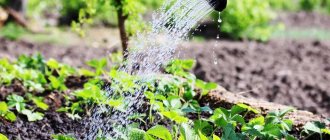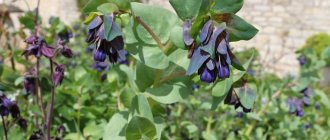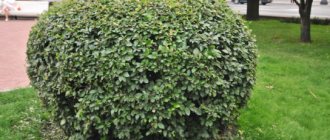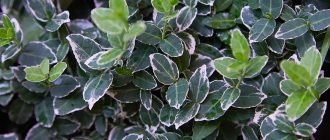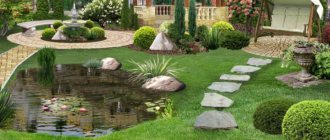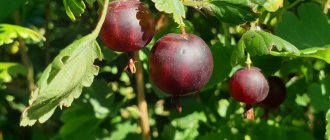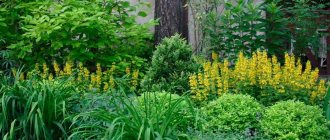Ornamental shrubs are widely used in garden landscaping. But if you decide to decorate your area with plants for the first time, then you need to know some rules. Here are the most win-win options for placing shrubs on your site.
The basic rules for creating a beautiful garden are:
- main color is green. Shrubs with bright and variegated leaves should only be spectacular spots against the background of natural greenery;
- When choosing plants, it is necessary to take into account the illumination of the garden. First of all, this applies to variegated forms, since their color fades in the shade;
- Contrasts should not be overused. Bright colors should be diluted with white and silver tones;
- It is important to consider the frost resistance of each shrub.
Group plantings of shrubs
In a simple group, plants of one species are used, and in a mixed group, two or more are used. In both cases, the shrubs should tolerate proximity to other “relatives”. Hydrangea and rhododendron perform well in the duet. In a mini-group you can plant keria, spirea, deutia and weigela.
To diversify the plantings, decorative trees can be planted next to the shrubs. For example, variegated euonymus, evergreen rhododendrons, golden spruce and fiery red maple look good in one composition. Quite an original group of finely serrated cherry, fan maple and euonymus. The combination of mock orange, derain and Japanese euonymus also looks good.
In landscape design, planting Thunberg barberry with different foliage colors is good
Important points when choosing bushes for your garden
You need to select plants based on the purpose for which the shrubs are used in the landscape. The functions assigned to them will require the selection of appropriate varieties.
- Practicality . Plants must cope with the demands. Some types are suitable for zoning, but completely different ones for decorating a summer gazebo. Plants with a strong root system are used to stop soil sliding on slopes. With the help of beautiful tall bushes you can disguise an unsightly corner in the yard. Plants covered in fragrant flowers will attract pollinating insects to the garden.
- Biological features . The selected varieties must be suitable for growing in the given climatic conditions. The composition of the soil and the location on the site must fully satisfy the plant’s needs for nutrition and lighting.
- Dimensions of an adult plant . When buying young seedlings, you need to ask in advance what size an adult plant can grow to and whether it will then be suitable for performing the functions assigned to it.
- Decorative qualities . Here it is worth paying attention to the appearance of the plant. For many, this is one of the fundamental parameters. From the whole variety of ornamental plants, you can choose a specimen that is ideal for the color and shape of the leaves, flowering time, flower color and their aroma.
- Compatibility . New bushes selected for landscape design should fit harmoniously with their appearance into the company of other plants used to decorate the site.
Advice! You should not choose shrubs based only on their decorative qualities. An incorrectly selected beautiful plant will not be able to fulfill its functions if it is planted in conditions unsuitable for its cultivation.
The direction of growth is another important point to pay attention to. All shrubs used in landscaping suburban areas are divided into three groups:
- Vertical . They are tall and resemble trees in appearance. They have a clear trunk and crown. For example, hawthorn.
- Horizontal . The width sometimes exceeds the height of the plant several times. A striking example is juniper.
- Globular . A group that unites plants with a rounded crown. For example, viburnum.
Shrubs for hedges
Hedges are located around the perimeter of the garden. Lilac, bladderwort, hawthorn, and mock orange are suitable for this role.
A lilac hedge grows quickly, so it is recommended for large areas
If you want to save space in the garden, give preference to molded (trimmed) hedges made of spirea, cotoneaster, barberry, snowberry, and privet.
- Fast growing shrubs for hedges
5 fast-growing shrubs that are ideal for forming a hedge.
- 10 plants for a hedge
What plants are best for creating a hedge?
Interesting neighborhood
The alleys are framed with borders, with dwarf or low varieties planted along them. It is permissible to use single plantings (tapeworms). Hydrangea, many-sided spirea and rhodendron successfully grow on lawns. Species that are not presentable in the dormant stage are collected in a composition of several plants.
To avoid the decorative superiority of individual varieties, proper combination is necessary. The scheme is quite complex and it is better to adhere to adapted practice. For example, the following versions are offered:
- group red-leaved barberries with rhodendron or fortisia;
- lilac will suit the neighborhood of Japanese quince, honeysuckle, as well as mock orange and universal rhodendron, which competes with rose in beauty;
- The hydrangea company is more suitable. A combination of red coleus (annual) with yellow-leaved barberry or hosto and its red-leaved counterpart is acceptable.
Mixborder of shrubs
Beautifully flowering (weigela, cinquefoil) and decorative deciduous (turf) shrubs are good in mixed plantings. They go well with herbaceous plants. But you should not combine too large specimens with strong roots (euonymus, hazel) with planting flowers. This depresses small plants.
All shrubs achieve maximum decorative value in open areas, although some can tolerate partial shade. But still, good lighting is preferable for them. Hawthorn, caragana, and almond are especially demanding of the sun, so you should not place them near tall buildings that create shade.
The role of shrub and tree groups in the garden
Not only flower beds, but also groups of trees and shrubs are responsible for the effect of fullness of the garden, the abundance and diversity of plants in it. They can be very different in size and number of plants, and even more so in their significance for the structure and artistic image. The main type of such groups is a small ensemble, which combines from 2 to 4 shrubs and decorative trees. Despite their small size and modest composition of “participants,” they are the main component of the skeletal plantings of the garden, providing vertical structure and impressive fullness. The modest size should not be misleading: such groups make a truly big impact and play a very significant role.
When they say that a skillful combination of shrubs and trees is the basis for the design of any garden, they are not far from the truth. Of course, the basis of landscape design is the structuring of space and the mutual relationship of basic elements, but shrubs and trees are the basis of landscaping and the main focal points that determine not only the style and appearance of the garden, but also its structure.
Functions of small groups of skeletal plants
Small groups of several bushes and trees, “organized” on two or three levels, are important zoning elements that determine the structure of the garden. They perform the function:
- the dominant, or visual basis of the compositions, the most massive, largest and attention-grabbing element, dictating the character and style; a focal point designed to attract the eye;
- a large masking element that hides functional and economic objects, a rest area, a secret path, etc.;
- a space divider, marking the boundary of a zone, a dividing point within a site, dividing large lawns or areas into separate zones, outlining transitions to important recreational facilities, a vegetable garden, etc.;
- filler, or a large element that adds volume and mass;
- a vertical accent that brings expressiveness and relief to the landscaping;
- a durable backdrop or background filler designed to create a colorful, high and expressive background for individual compositions for decades, etc.
The influence of ensembles of trees and shrubs on the style of the garden
Combinations of shrubs and trees together form the so-called skeletal plantings, the same “canvas” on which herbaceous perennials and annuals flaunt, which shades areas and lawns and creates the effect of fullness. Sometimes groups of trees play only a structuring role, being a dominant, distracting or masking element, but, as a rule, their practical and decorative functions are inseparable.
Regardless of their specific role, their main function in the garden remains the formation of a basis for landscaping and garden style. The right combination of trees and shrubs allows you to create complete projects even in the smallest area. If single plants are only dominant, creating catchy and large accents, then groups of trees and shrubs are a style-forming element.
Trees and shrubs in garden design. © Dave
For what purposes are evergreen bushes grown?
Basically, bright hedges are made from beautiful evergreen shrubs. In addition, bushes can serve as a decoration element. Let's look at the main types of bushes that do not lose their green color even in winter.
Magnolia
A bush no more than 1 m high with beautiful green leaves. For a long time, the plant is able to maintain foliage, slightly changing only its color.
So, in the warm season the leaves are green in color, and in the cold season they acquire a copper tint.
Honeysuckle
Another green bush. It has a height of no more than 50 cm. It can grow in the shade, this will not affect its condition in any way. In winter, it is recommended to cover honeysuckle.
Rhododendrons
A low bush growing in a shady area. It is not recommended to water frequently. In winter, the plant also needs to be covered.
Trees are divided into three categories based on size:
- Pine and larch, more than 25 meters high
- Poplar, spruce, birch, linden, maple (15-25m)
- Rowan, apple tree, bird cherry (10-15m.)
The tone of foliage is one of the most important qualities of trees. Having a large size and, accordingly, visual power, the crown of trees and the color of its leaves play a huge role in the color scheme of the garden. The main color of deciduous and coniferous trees is green. But, firstly, it has many shades, and secondly, it changes over the course of the year…….
Texture is another important property of trees. Does this include the texture and shape of the trunks? and branches?, leaf pattern, shape and color of inflorescences and fruits. Picturesque golden shades of pine bark, curved relief oak branches, flowering horse chestnut candles and red rowan beads are some of the multifaceted manifestations of the diversity of textures in the plant kingdom.
Chiaroscuro is a quality inherent only to trees, and all thanks to their size. It can be dense with clear contours or openwork - transparent, lace. Spruce, willow, chestnut, pyramidal forms of poplar, oak, and thuja have dense chiaroscuro. Transparent chiaroscuro is more common in pine trees, large forms of linden, apple trees, and birch. Often this quality changes with the age of the tree or depends on growing conditions, soil, insolation, and planting density. This important property is taken into account when combining trees with other plants that fall in their shade and when composing compositions.
A distinctive feature of trees compared to other components of the landscape is the differentiation of their decorative qualities depending on the point and viewing distance. If you are under the canopy of an oak tree, you enjoy its openwork shadow, textured bark, powerful trunk with spreading roots, and acorns scattered on the ground. Move to the edge of its crown and your eye will be drawn by the widely spread branches and beautifully indented leaves hanging from the side branches. Another 30 meters to the side - and we begin to see the dome shape of the crown and the skeletal structure of the branches. And from a hundred meters its color difference from the green background is noticeable. The color of the leaves and branches merge into a single tone, which highlights the shape of the tree against the background of the surrounding plants.


